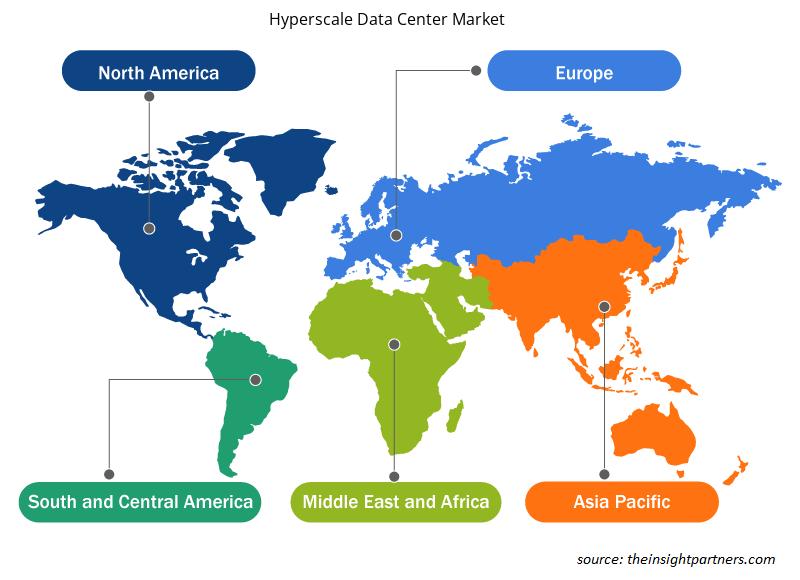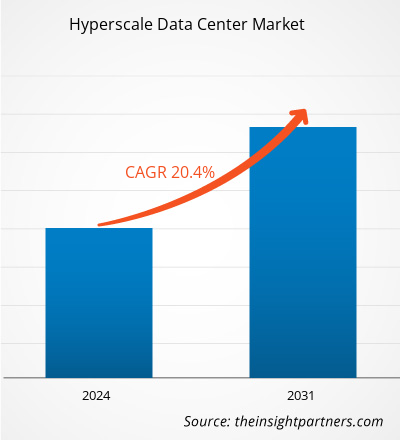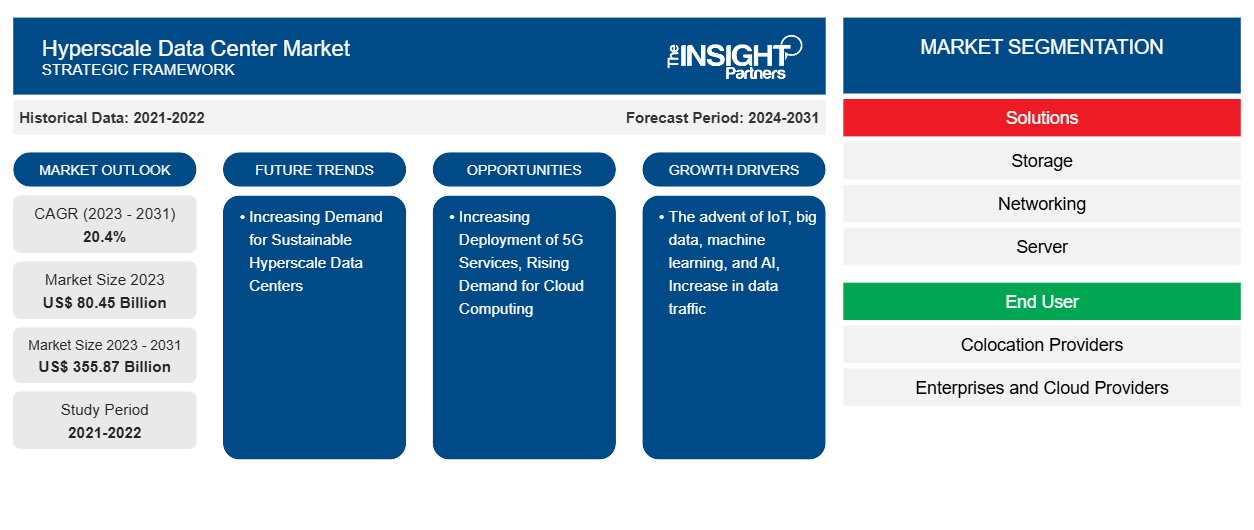Das Marktvolumen für Hyperscale-Rechenzentren soll von 80,45 Milliarden US-Dollar im Jahr 2023 auf 355,87 Milliarden US-Dollar im Jahr 2031 anwachsen. Von 2023 bis 2031 wird für den Markt eine durchschnittliche jährliche Wachstumsrate (CAGR) von 20,4 % erwartet. Die Integration des IoT dürfte im Prognosezeitraum wichtige Markttrends mit sich bringen.
Marktanalyse für Hyperscale-Rechenzentren
Der Bericht enthält Wachstumsaussichten aufgrund der aktuellen Trends auf dem Markt für Hyperscale-Rechenzentren und ihrer vorhersehbaren Auswirkungen während des Prognosezeitraums. Hyperscale-Rechenzentren erfreuen sich aufgrund ihrer Eigenschaften wie hoher Rechen-, Speicher- und Bandbreitenkapazitäten einer erheblichen Nachfrage. Darüber hinaus trägt ihre Fähigkeit, riesige Datenmengen zu bewegen, zu ihrer Popularität bei. Diese Rechenzentren sind kostengünstig, skalierbar, sicherer, zuverlässiger und weniger umweltschädlich. Hyperscale-Rechenzentren bieten Dienste wie Datenspeicherung, -verwaltung, -sicherung und -wiederherstellung. Sie betreiben auch Online-Gaming-Communitys, erleichtern Transaktionen mit hohem Volumen und unterstützen die Implementierung modernster Technologien (wie Big Data, maschinelles Lernen und künstliche Intelligenz). Infolgedessen haben viele Unternehmen und Regierungsorganisationen begonnen, ihre eigenen Rechenzentren zu verwalten oder Drittanbieter wie Google und Amazon für Cloud-basierten Speicher oder sogar Servermieten zu beauftragen, was das Wachstum des Marktes für Hyperscale-Rechenzentren während des Prognosezeitraums weiter vorantreiben wird.
Marktübersicht für Hyperscale-Rechenzentren
Hyperscale-Rechenzentren mit ihren enormen Rechen-, Speicher- und Bandbreitenkapazitäten sowie ihrem Potenzial, enorme Datenübertragungsmengen zu bewältigen, haben die Rechenzentrumsbranche revolutioniert . Diese Entwicklung hat die Art und Weise, wie Unternehmen interagieren und zusammenarbeiten, völlig verändert. Mit der Einführung von Homeoffice-Richtlinien in verschiedenen Organisationen weltweit seit Beginn der COVID-19-Pandemie ist die Nachfrage nach Rechenzentren kontinuierlich gestiegen. Verschiedene große Organisationen wie Facebook und Twitter sowie Finanz- und professionelle Dienstleistungsunternehmen erlaubten ihren Mitarbeitern während der Pandemie, von zu Hause aus zu arbeiten, was zu einem der Hauptgründe für die steigende Nachfrage nach Hyperscale-Rechenzentren weltweit wurde.
Passen Sie diesen Bericht Ihren Anforderungen an
Sie erhalten kostenlos individuelle Anpassungen an jedem Bericht, einschließlich Teilen dieses Berichts oder einer Analyse auf Länderebene, eines Excel-Datenpakets sowie tolle Angebote und Rabatte für Start-ups und Universitäten.
-
Holen Sie sich die wichtigsten Markttrends aus diesem Bericht.Dieses KOSTENLOSE Beispiel umfasst eine Datenanalyse von Markttrends bis hin zu Schätzungen und Prognosen.
Treiber und Chancen auf dem Markt für Hyperscale-Rechenzentren
IoT, Big Data, maschinelles Lernen und KI treiben das Wachstum im Markt für Hyperscale-Rechenzentren voran
Das Internet der Dinge (IoT), Big Data , maschinelles Lernen und künstliche Intelligenz (KI) sind einige Technologien, die riesige Datenmengen erzeugen, eine Verarbeitung mit geringer Latenzzeit erfordern und lokale Rechenressourcen erfordern. IoTExpress Technologies Pvt. Ltd. prognostiziert, dass die Zahl der IoT-Geräte im asiatisch-pazifischen Raum bis Ende 2023 die Marke von 15 Milliarden überschreiten wird, was einem Anstieg von 55 % gegenüber 2020 entspricht. Darüber hinaus wird erwartet, dass diese Geräte bis 2025 79,4 Zettabyte (ZB) an Daten erzeugen. IoT erzeugt riesige Datenmengen, die in Echtzeit verarbeitet, gespeichert und analysiert werden müssen. IoT-Geräte sind in der gesamten Region weit verbreitet, verbinden verschiedene physische Objekte und ermöglichen die Datenerfassung und -kommunikation. Die am Rand des Netzwerks positionierten Rechenzentren können lokale Rechenleistung, Speicher- und Analysefunktionen bereitstellen und so die Latenz- und Bandbreitenanforderungen reduzieren, während Daten an ein zentrales Rechenzentrum übertragen werden. Sie können auch Entscheidungen in Echtzeit ermöglichen und IoT-Bereitstellungen in den Branchen Fertigung, Gesundheitswesen, Transport und Smart City erleichtern. Darüber hinaus erfordert die Verarbeitung und Analyse solch massiver Datensätze erhebliche Rechenleistung und Speicherkapazitäten. Hyperscale-Rechenzentren bieten eine skalierbare und verteilte Architektur, die es Unternehmen ermöglicht, große Datenmengen zu verarbeiten und zu analysieren. Darüber hinaus verbessern sie die Effizienz der Datenverarbeitung und ermöglichen Echtzeitanalysen. Auch maschinelles Lernen und KI-Algorithmen erfordern erhebliche Rechenressourcen für Trainings- und Inferenzaufgaben. Hyperscale-Rechenzentren bieten die erforderliche Rechenleistung und Speicherkapazität, um diese ressourcenintensiven Aufgaben in der Nähe der Datenquelle auszuführen. Unternehmen können die Latenz reduzieren, indem sie Hyperscale-Rechenzentren am Rand einsetzen. Dies ermöglicht Entscheidungen in Echtzeit, verbessert KI-gesteuerte Anwendungen und unterstützt Anwendungsfälle wie autonome Fahrzeuge, intelligente Videoanalyse, vorausschauende Wartung und personalisierte Empfehlungen. Daher stärkt das Aufkommen von Technologien wie IoT, maschinellem Lernen, Big Data und KI den Markt für Hyperscale-Rechenzentren.
Steigende Nachfrage nach Cloud Computing
Cloud Computing bietet eine kostengünstige Möglichkeit, Daten zu verarbeiten. Unternehmen können sie an einem zentralen Ort speichern und verarbeiten, ohne in teure Hardware und Infrastruktur investieren zu müssen. Die zunehmende Nutzung von Cloud Computing-Diensten treibt die Nachfrage nach Hyperscale-Rechenzentrumsdiensten voran. Die Integration von Cloud-Technologien mit vernetzten Geräten und Systemen hat zu einer stärkeren Präferenz für diese Geräte geführt, was wiederum einen wachsenden Bedarf an Hochgeschwindigkeits-Netzwerkkonnektivität mit geringer Latenz zur Folge hat. Hyperscale-Rechenzentren bieten eine sichere Hardwareumgebung zum Speichern und Zugreifen auf Daten, die für die Unterstützung von IoT- und Cloud-basierten Anwendungen unerlässlich ist und zur Einsparung von Gesamtkosten beiträgt.
Mit der zunehmenden Verbreitung von Cloud-basierten Technologien gründen wichtige Akteure auf dem Markt für Hyperscale-Rechenzentren neue Einheiten für ihre Unternehmen, um die Cloud und die digitale Infrastruktur zugänglicher zu machen. Im September 2021 eröffnete Vantage Data Centres mithilfe von zwei Übernahmen und einer Kapitalerhöhung von 1,5 Milliarden US-Dollar unter der Leitung von DigitalBridge Investment Management eine neue Einrichtung in APAC. Mit dieser Expansion begann das Unternehmen, Cloud-basierte Dienste in Tokio und Osaka (Japan), Hongkong (China), Kuala Lumpur (Malaysia) und Melbourne (Australien) anzubieten. Die Eröffnung neuer Rechenzentren zieht mehr Kunden an, die die Dienste fortschrittlicher Technologien nutzen möchten. Daher wird erwartet, dass die anhaltende Verbreitung von Cloud-basierten Diensten das Wachstum des Marktes für Hyperscale-Rechenzentren im Prognosezeitraum ankurbeln wird.
Segmentierungsanalyse des Marktberichts für Hyperscale-Rechenzentren
Wichtige Segmente, die zur Ableitung der Marktanalyse für Hyperscale-Rechenzentren beigetragen haben, sind Lösung, Endbenutzer und Vertikale.
- Basierend auf der Lösung ist der Markt in Speicher, Netzwerk, Server, Sicherheit und Sonstiges unterteilt. Das Speichersegment hatte im Jahr 2023 den größten Marktanteil bei Hyperscale-Rechenzentren.
- Nach Endbenutzern ist der Markt in Unternehmen, Colocation-Anbieter und Cloud-Anbieter segmentiert. Das Segment der Colocation-Anbieter dominierte den Markt im Jahr 2023.
- Vertikal gesehen ist der Markt für Hyperscale-Rechenzentren in BFSI, Telekommunikation und IT, Medien und Unterhaltung, Regierung und Öffentlichkeit und andere segmentiert. Das BFSI-Segment dominierte den Markt im Jahr 2023.
Marktanteilsanalyse für Hyperscale-Rechenzentren nach geografischer Lage
- Der Markt für Hyperscale-Rechenzentren ist in fünf große Regionen unterteilt: Nordamerika, Europa, Asien-Pazifik (APAC), Naher Osten und Afrika (MEA) sowie Süd- und Mittelamerika. Nordamerika dominierte den Markt im Jahr 2023, gefolgt von Europa und APAC.
- Nordamerika hatte im Jahr 2023 den größten Marktanteil im Bereich Hyperscale-Rechenzentren. Die wichtigsten nordamerikanischen Länder konzentrieren sich hauptsächlich auf die Verbesserung der Unternehmensinfrastruktur und die Entwicklung neuer Technologien. Durch Fortschritte im Unternehmenssektor werden erhebliche Datenmengen generiert, die effizient verarbeitet und gespeichert werden müssen. Die Mehrheit der dominierenden Unternehmen auf dem Rechenzentrumsmarkt hat ihren Hauptsitz in Nordamerika. Darüber hinaus nutzen Unternehmen zunehmend Managed Services, Colocation, Cloud-Dienste und zusätzliche Hybridmethoden, um neue Produkte und Dienstleistungen einzuführen, innovative Geschäftsmodelle zu bewerten und stärkere Verbindungen zu ihrer Kundschaft aufzubauen. Alle oben genannten Faktoren treiben also das Wachstum des Marktes für Hyperscale-Rechenzentren in der Region voran.
Regionale Einblicke in den Markt für Hyperscale-Rechenzentren
Die regionalen Trends und Faktoren, die den Markt für Hyperscale-Rechenzentren im Prognosezeitraum beeinflussen, wurden von den Analysten von Insight Partners ausführlich erläutert. In diesem Abschnitt werden auch die Marktsegmente und die Geografie von Hyperscale-Rechenzentren in Nordamerika, Europa, im asiatisch-pazifischen Raum, im Nahen Osten und Afrika sowie in Süd- und Mittelamerika erörtert.

- Erhalten Sie regionale Daten zum Markt für Hyperscale-Rechenzentren
Umfang des Marktberichts zum Hyperscale-Rechenzentrum
| Berichtsattribut | Details |
|---|---|
| Marktgröße im Jahr 2023 | 80,45 Milliarden US-Dollar |
| Marktgröße bis 2031 | 355,87 Milliarden US-Dollar |
| Globale CAGR (2023 - 2031) | 20,4 % |
| Historische Daten | 2021-2022 |
| Prognosezeitraum | 2024–2031 |
| Abgedeckte Segmente |
Nach Lösungen
|
| Abgedeckte Regionen und Länder |
Nordamerika
|
| Marktführer und wichtige Unternehmensprofile |
|
Marktdichte von Hyperscale-Rechenzentren: Auswirkungen auf die Geschäftsdynamik verstehen
Der Markt für Hyperscale-Rechenzentren wächst rasant. Dies wird durch die steigende Nachfrage der Endnutzer aufgrund von Faktoren wie sich entwickelnden Verbraucherpräferenzen, technologischen Fortschritten und einem größeren Bewusstsein für die Vorteile des Produkts vorangetrieben. Mit der steigenden Nachfrage erweitern Unternehmen ihr Angebot, entwickeln Innovationen, um die Bedürfnisse der Verbraucher zu erfüllen, und nutzen neue Trends, was das Marktwachstum weiter ankurbelt.
Die Marktteilnehmerdichte bezieht sich auf die Verteilung der Firmen oder Unternehmen, die in einem bestimmten Markt oder einer bestimmten Branche tätig sind. Sie gibt an, wie viele Wettbewerber (Marktteilnehmer) in einem bestimmten Marktraum im Verhältnis zu seiner Größe oder seinem gesamten Marktwert präsent sind.
Die wichtigsten Unternehmen auf dem Markt für Hyperscale-Rechenzentren sind:
- ABB Ltd
- Dell Inc
- EdgeConneX Inc
- Cisco Systems Inc
- International Business Machines Corp
- Fujitsu Ltd
Haftungsausschluss : Die oben aufgeführten Unternehmen sind nicht in einer bestimmten Reihenfolge aufgeführt.

- Überblick über die wichtigsten Akteure auf dem Markt für Hyperscale-Rechenzentren
Neuigkeiten und aktuelle Entwicklungen zum Markt für Hyperscale-Rechenzentren
Der Markt für Hyperscale-Rechenzentren wird durch die Erhebung qualitativer und quantitativer Daten nach Primär- und Sekundärforschung bewertet, die wichtige Unternehmensveröffentlichungen, Verbandsdaten und Datenbanken umfasst. Nachfolgend sind einige der Entwicklungen auf dem Markt für Hyperscale-Rechenzentren aufgeführt:
- Digital Realty, der weltweit größte Anbieter von Cloud- und Carrier-neutralen Rechenzentrums-, Colocation- und Verbindungslösungen, und Blackstone Inc. haben bekannt gegeben, dass mit Blackstone verbundene Fonds unter der Leitung von Infrastructure, Real Estate und Tactical Opportunities vereinbart haben, ein Joint Venture mit Digital Realty zu gründen, um vier Hyperscale-Rechenzentrumscampusse in drei Metropolregionen auf zwei Kontinenten zu entwickeln. Die Entwicklungen werden voraussichtlich bei vollständiger Auslastung aller Campusse eine IT-Gesamtlast von etwa 500 Megawatt (MW) unterstützen.
(Quelle: Digital Realty, Pressemitteilung, Dezember 2023)
- IXAfrica Data Centres hat in Nairobi das erste und größte hyperskalige KI-fähige Rechenzentrum Ostafrikas eröffnet, um globale Hypercloud-Kunden anzulocken. Schneider Electric unterstützt die Eröffnung mit einem hoch belastbaren Antriebsstrang, der Transformatoren, Mittelspannungs- und Niederspannungsschaltanlagen, Stromverteilung und USV-Backup sowie EcoStruxure-Managementlösungen umfasst.
(Quelle: Schneider Electric, Pressemitteilung, Juli 2024)
Marktbericht zu Hyperscale-Rechenzentren – Abdeckung und Ergebnisse
Die „Marktgröße und Prognose für Hyperscale-Rechenzentren (2021–2031)“ bietet eine detaillierte Analyse des Marktes, die die unten genannten Bereiche abdeckt:
- Marktgröße und Prognose für Hyperscale-Rechenzentren auf globaler, regionaler und Länderebene für alle wichtigen Marktsegmente, die im Rahmen des Berichts abgedeckt sind
- Markttrends für Hyperscale-Rechenzentren sowie Marktdynamik wie Treiber, Einschränkungen und wichtige Chancen
- Detaillierte PEST- und SWOT-Analyse
- Marktanalyse für Hyperscale-Rechenzentren mit Blick auf wichtige Markttrends, globale und regionale Rahmenbedingungen, wichtige Akteure, Vorschriften und aktuelle Marktentwicklungen
- Branchenlandschaft und Wettbewerbsanalyse, einschließlich Marktkonzentration, Heatmap-Analyse, prominenten Akteuren und aktuellen Entwicklungen für den Markt für Hyperscale-Rechenzentren
- Detaillierte Firmenprofile
- Historische Analyse (2 Jahre), Basisjahr, Prognose (7 Jahre) mit CAGR
- PEST- und SWOT-Analyse
- Marktgröße Wert/Volumen – Global, Regional, Land
- Branchen- und Wettbewerbslandschaft
- Excel-Datensatz
Aktuelle Berichte
Verwandte Berichte
Erfahrungsberichte
Grund zum Kauf
- Fundierte Entscheidungsfindung
- Marktdynamik verstehen
- Wettbewerbsanalyse
- Kundeneinblicke
- Marktprognosen
- Risikominimierung
- Strategische Planung
- Investitionsbegründung
- Identifizierung neuer Märkte
- Verbesserung von Marketingstrategien
- Steigerung der Betriebseffizienz
- Anpassung an regulatorische Trends























 Kostenlose Probe anfordern für - Markt für Hyperscale-Rechenzentren
Kostenlose Probe anfordern für - Markt für Hyperscale-Rechenzentren